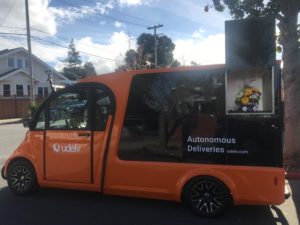If you are reading this as a representative of your company’s finance or HR team, you should realize the potential benefits of self-driving cars. Cut commuting costs, erase the annoying parts of air travel, expand retail stores’ revenues, and revolutionize deliveries.
But how exactly does the innovation of self-driving cars factor into your growing business? In an analysis, corporate travel programs should run a side-by-side comparison between self-driving cars and first-class air travel. The results just might shock you.
A Brief History of Self-Driving Cars
The interesting thing about horses as society’s main form of transportation is that they can actually drive themselves. A human rider may be needed to spur the horse to move, or course-correct every so often. But under certain circumstances, the rider can strap in safely and take a nap, read a sonnet, shoot arrows, or do whatever it is people enjoyed doing for the last few thousand years. The horse was a (tongue-in-cheek) self-driving car.

But then came the gas engine. This required a starter- undoing the parking brake and pressing the pedal. Humans needed to steer, brake, and navigate. As time went on, the driver and the vehicle become inseparable. Compared to the horse, the gas-powered vehicle gave us increased mobility at the cost of increased work (and dozens of environmental issues caused by exhaust, urban sprawl, and car-related construction, but that’s a subject for another time.)
Perhaps since the first car went on the road with Karl Benz’s Patent Motorwagen in 1886, drivers yearned for the experience of the drive, without the burden of having to do it.
In 1939, a young General Motors awed the world with their Futurama Display at the New York World’s fair, pictured below. Their display included a future of mobility highlighted by a self-driving car that will free the driver and permit a freedom previously unseen in the modern vehicle.

Since then, the holy grail of self-driving cars has been continually put off. Regulatory restrictions (mandates that car companies focus on driver safety instead of experimental technologies) were tightened after Ralph Nader’s 1965 book, “Unsafe At Any Speed” proved how unsafe cars already were. Technology, specifically deep learning artificial intelligence and GPUs, did not develop as quickly as visionary timelines required.
All in all, self-driving cars were promised, hoped for, delayed, and, eventually, laughed off, relegated to science fiction-like technologies without real benefits, like was seen withchatbots and virtual reality
But just like with chatbots and VR, self-driving cars are beginning to find their use case in the real world. starting with the 2007 DARPA challenge, a host of companies have been bringing true self-driving technologies to market with ever-increasing rapidity. These vehicles are no longer vague promises. They’re not even as far off as ‘on the horizon’. They’re on our roads, serving passengers, doing deliveries, and revolutionizing what it means to live, work, and move in the 21st century.
Below are four ways in which self-driving cars will change business.
Self-driving cars will reimagine the commute
In the United States, the average commute is over 25 minutes- each way. According to Brookings, 90% of Americans drive their cars to work every day and suffer the associated costs. Self-driving cars, especially if widely and cheaply available as a ride-sharing service from a company like Lyft or Uber, can remove the upfront cost of purchasing a car and the associated upkeep gas and maintenance costs.

But the benefit doesn’t stop at the rider. With over 21 billion hours spent commuting to work each year, as calculated by the Washington Post, employees spend an entire workday per week on the commute- a cost that burdens the employer as much as it inconveniences the employee. The cost of gas and car ownership shrinks in comparison to the steep cost of lost-work.
So if you are reading this as a representative of your company’s finance or HR team, you should realize the potential benefits of self-driving cars. Commuting costs – whether directly subsidized or paid in terms of salary and bonus – directly decrease as travel becomes cheaper. Employees no longer arrive to work stressed after navigating 25 minutes of traffic with a cup of coffee as their only hope of staying alert. And your business gains happier, more productive employees at a much lower cost.
Self-driving cars can diversify business travel options
Business travel permits the education, networking, and negotiation that drives the modern economy. Around the world, companies spend over 1.3 trillion dollars, according to Statista, sending their employees on trips to attend conferences, go to meetings, and manage projects. A huge percentage of this cost is spent on planes.

And planes are great, and fairly easy to access considering you’re flying 40,000 feet in the air. Just get a ride to an airport, go through security, wait at your gate for a while, get on the plane, sit for a few hours, get off the plane, catch a cab to your hotel, and you did it- you just crossed the world faster and with less risk than any creature in the history of our Earth. Not bad.
The only thing that might be a bit easier were if you did that same thing, without any of the middle steps. Just get in a car, sit for a while, and get out of a car. And you’re there.
One of the promises of self-driving cars is creating a new low-cost option for long distance travel. This promise comes with a few assumptions.
- Self-driving cars can travel ~200mph. This is according to Greg Votolato, a design history expert and tutor at the Royal College of Art Vehicle Design program. That’s because they can make decisions faster and know more about other cars on the roads than any human driver. If cars are driven by computers, and computers are able to talk to each other over the internet, then all the unpredictability of human drivers is replaced by the rigor and clean efficiency of computing power.
- Self-driving cars can be great work and experiential spaces. Planes, limited in space and weight capacities, offer wi-fi infrequently and limit workspaces to those tiny meal desks which we can barely get open. Entertainment is limited to small screens 6 inches from our noses. Self-driving cars, as is discussed further in the last section, can be designed to meet an individuals work and entertainment needs like no other form of transportation.
- Self-driving cars are as safe as planes. Self-driving cars promise to drive at least 10X as safe as modern humans- though that number is likely an underestimate. When – not if – they deliver on safety (their most important promise), they’ll be acceptable forms of long-term transportation.
Knowing all that – and assuming that it is possible – let’s reimagine your trip to a conference. You call a car to your home. A self-driving pod arrives. It has one seat that reclines comfortably (pay extra for the ‘first class’ full bed). It has a desk for you to eat or work on. Or, if you’re traveling with co-workers, maybe the pod is a bit bigger and is covered in smart-boards for collaborative ideation. And the entertainment? Well, every pane of glass is transformed into a surround sound entertainment system to make your trip enjoyable.
Riding at 200 miles per hour, you can go from San Francisco to Las Vegas in <3 hours. New York City to Washington D.C. in 90 minutes. And the cost? You’re charged $0.60/mile, just like in a rental car. So while a bit more expensive than a standard flight, you’ve just shaved off all travel inconvenience and finally had a chance to rest without your snoring neighbor blocking distracting you from reading your book.
And just like with established forms of transportation, from flight to rail, various prices will get you varying experiences. Pay extra for a “sleeper vehicle” so you can rest on a long trip. Purchase an ‘HOV’ membership which gets you into the fast lane at 50mph quicker speeds than normal. Or travel economy- a measly 200mph, and likely with a few strangers sitting next to you in your cabin.
And if you want to save cost and add a little time to the trip, just take a self-driving bus. It might travel a tad slower, but with a dedicated lane and lower carbon footprint, it might be worth it.
Self-driving cars will make all retail mobile (on the move, not on your phone)
Self-driving cars are going to change what it means to have a location. And with the core law of retail being “location, location, location”, you can bet this business will be dramatically impacted.
Firstly, cheap and easy transportation accessible by anyone, anywhere, at any time will mean that a retail stores’ revenues are not limited to only those people who live nearby. Access to a shopping center can now be spread over a wider radius to increase revenues. Retailers aiming to tap into this new market and providing elite customer service may actually send a cheap, self-driving vehicle to pick up a family from their home and bring them to the store, as described by Deloitte. This is a potential associated cost increase that might fall under the ‘business travel’ budget, bringing a whole new meaning to travel expenses.
Secondly, self-driving cars are going to change the entire business of delivery. Amazon’s aggressive innovation into convenience and logistics has already made consumers expect cheap, fast, and easy delivery. This, however, comes at an enormous cost for Amazon. GeekWire reported that Amazon lost over $7 billion on delivery in 2016.
Companies like udelv, Nuro, and Starship Technologies are aiming at lowering the cost of deliveries by removing the driver from the equation.
udelv, for example, aims to lower the cost of delivery by 50%. This would have enormous benefits for any business shipping goods (like Amazon). These cost savings would, we hope, be translated to recipients as well. If your business sends or receives anything, including food, gifts, and supplies, you can benefit from the impact of self-driving cars on retail.

Self-driving will redefine the very concept of a car
If you’re going to take one point away from this article, it should be that a self-driving car of the future is nothing like a modern car, even if it has the same root word. It will be a method of transportation, not a vehicle to be driven. This change in wording seems minor, but has enormous consequences.
At the Consumer Electronics Show this year (2018), Toyota released a design to drive this point home (pun intended). Toyota’s e-palette is an example of the design theory that will lead self-driving cars to change the way we move, live, and do business. Car designers will be able to partner with businesses to create transportation-boxes with experiences ranging from coffee-shop to office space. These vehicles can be called on a whim to enable shopping, traveling, and entertainment.

So when are self-driving cars coming?
Companies like Waymo, Uber, and udelv all have self-driving cars on the roads already. Waymo, formerly a Google company, even claims that their vehicles have driven over 5 million miles– each one adding to the computer’s experience and abilities.
While technology companies always seem to be a bit ahead of government in their timelines, regulation seems to be catching up. States like Arizona and Florida already permit full testing of autonomous vehicles. Countries like Singapore, Japan, and Germany have been permitting self-driving car tests for over a decade.
The “when will they be here” question is too general to be easily answered. When will all rides in the United States happen in a self-driving car? Perhaps not for 100 years, if ever. When will 50% of Americans own a self-driving car? Perhaps never, as they’ll likely be owned by companies like Lyft and rented out to us when we need them.
But when will you or I, the average American citizen, be able to ride in a self-driving car? Well- that day has already arrived.